NSC2500 Video Presentation: Varicella Pathophysiology and Acyclovir
VerifiedAdded on 2022/12/23
|17
|1706
|3
Presentation
AI Summary
This presentation provides an overview of chickenpox (varicella), a viral infection caused by the varicella-zoster virus. It discusses the transmission, symptoms, and pathophysiology of the disease, including the role of host immunoglobulins and the virus's latency in sensory nerves. The presentation also details the pharmacology of acyclovir, an antiviral drug used to manage chickenpox symptoms, covering its pharmacodynamics, pharmacokinetics, routes of administration, indications, contraindications, precautions, and side effects. It emphasizes the relevance of vaccination in preventing chickenpox outbreaks and highlights the importance of appropriate acyclovir usage to minimize potential adverse effects. The presentation concludes by stressing the need for strengthened surveillance systems and increased vaccination rates to ensure future health and prevent chickenpox outbreaks.
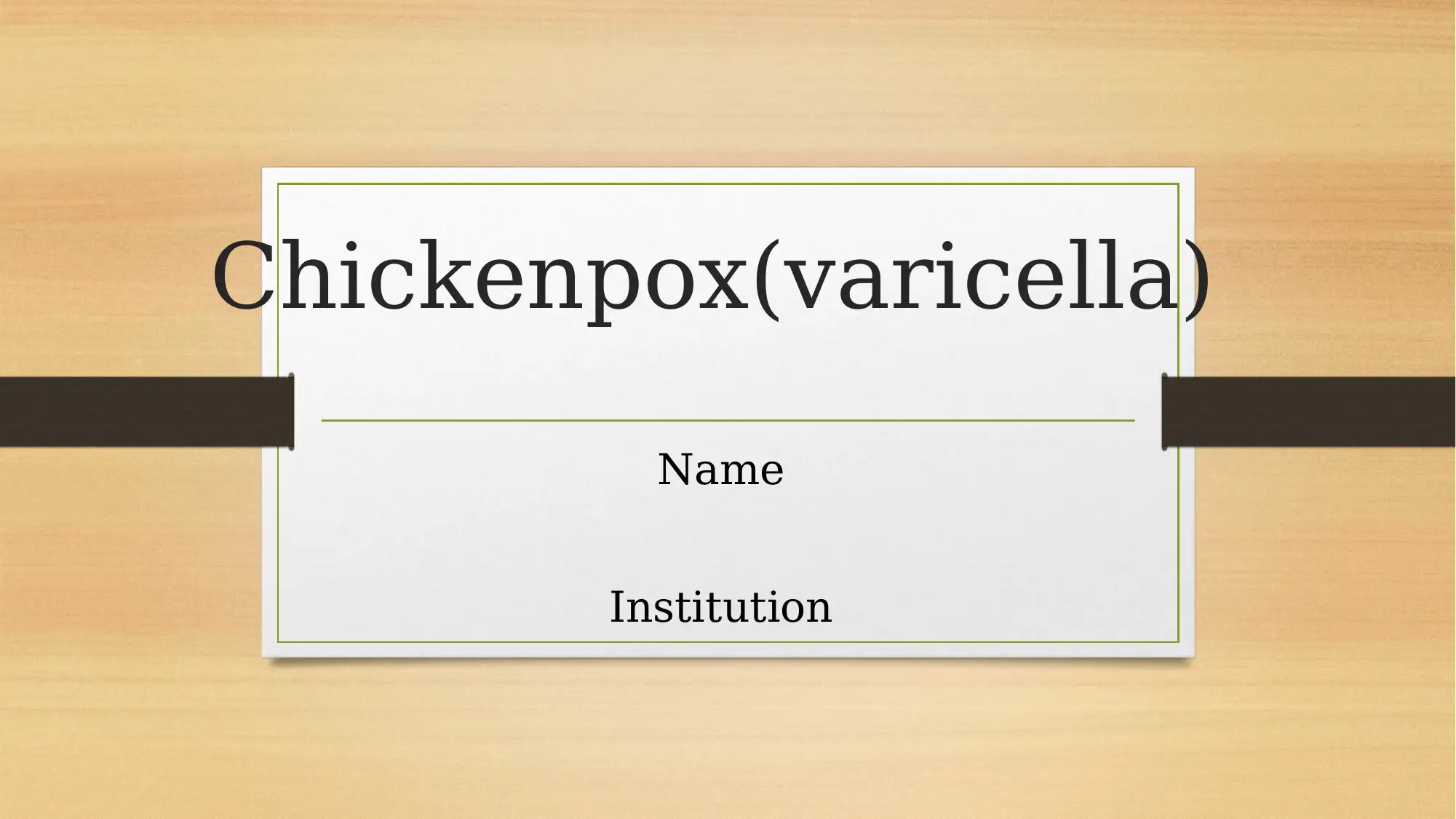
Chickenpox(varicella)
Name
Institution
Name
Institution
Paraphrase This Document
Need a fresh take? Get an instant paraphrase of this document with our AI Paraphraser
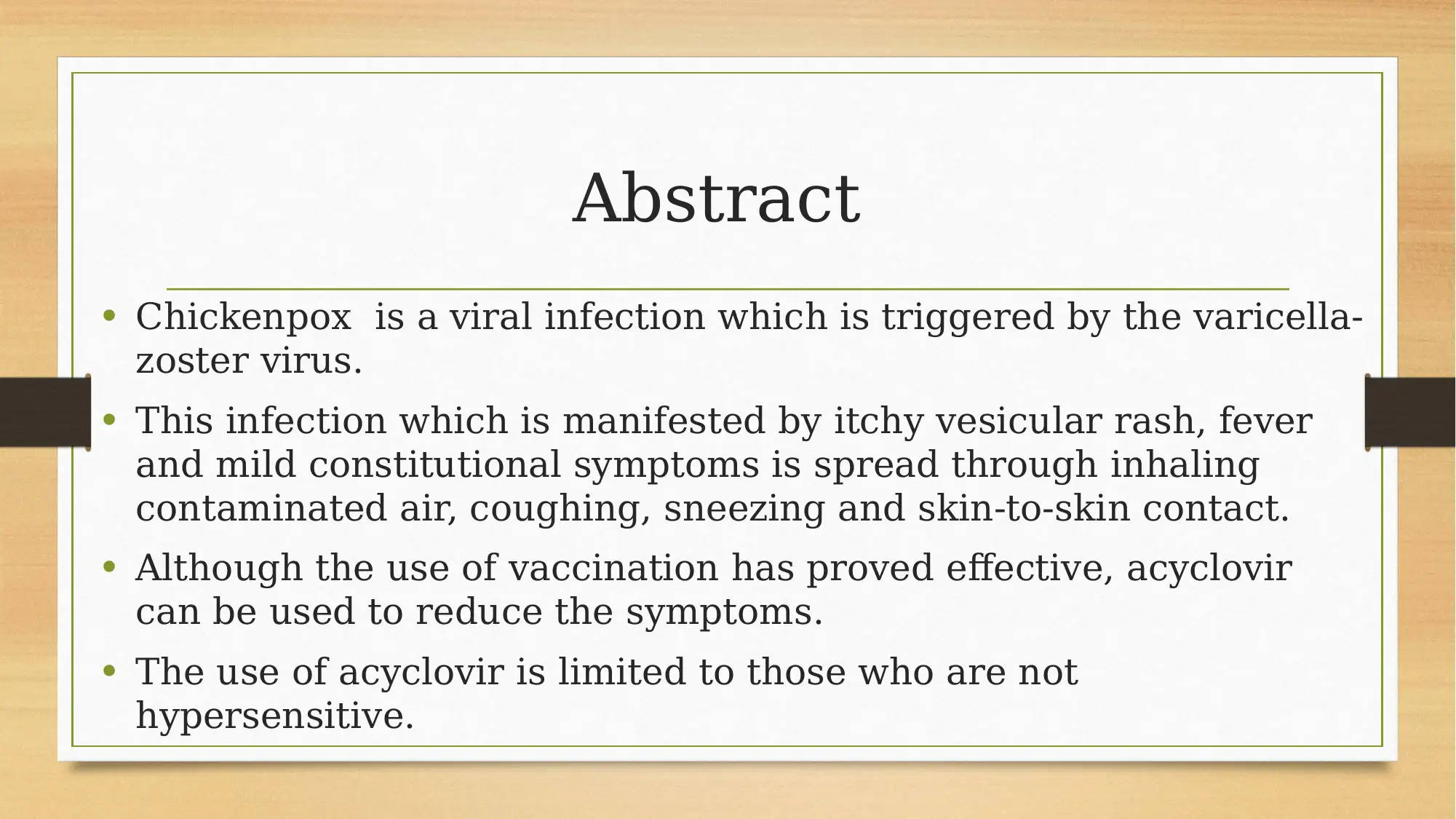
Abstract
• Chickenpox is a viral infection which is triggered by the varicella-
zoster virus.
• This infection which is manifested by itchy vesicular rash, fever
and mild constitutional symptoms is spread through inhaling
contaminated air, coughing, sneezing and skin-to-skin contact.
• Although the use of vaccination has proved effective, acyclovir
can be used to reduce the symptoms.
• The use of acyclovir is limited to those who are not
hypersensitive.
• Chickenpox is a viral infection which is triggered by the varicella-
zoster virus.
• This infection which is manifested by itchy vesicular rash, fever
and mild constitutional symptoms is spread through inhaling
contaminated air, coughing, sneezing and skin-to-skin contact.
• Although the use of vaccination has proved effective, acyclovir
can be used to reduce the symptoms.
• The use of acyclovir is limited to those who are not
hypersensitive.
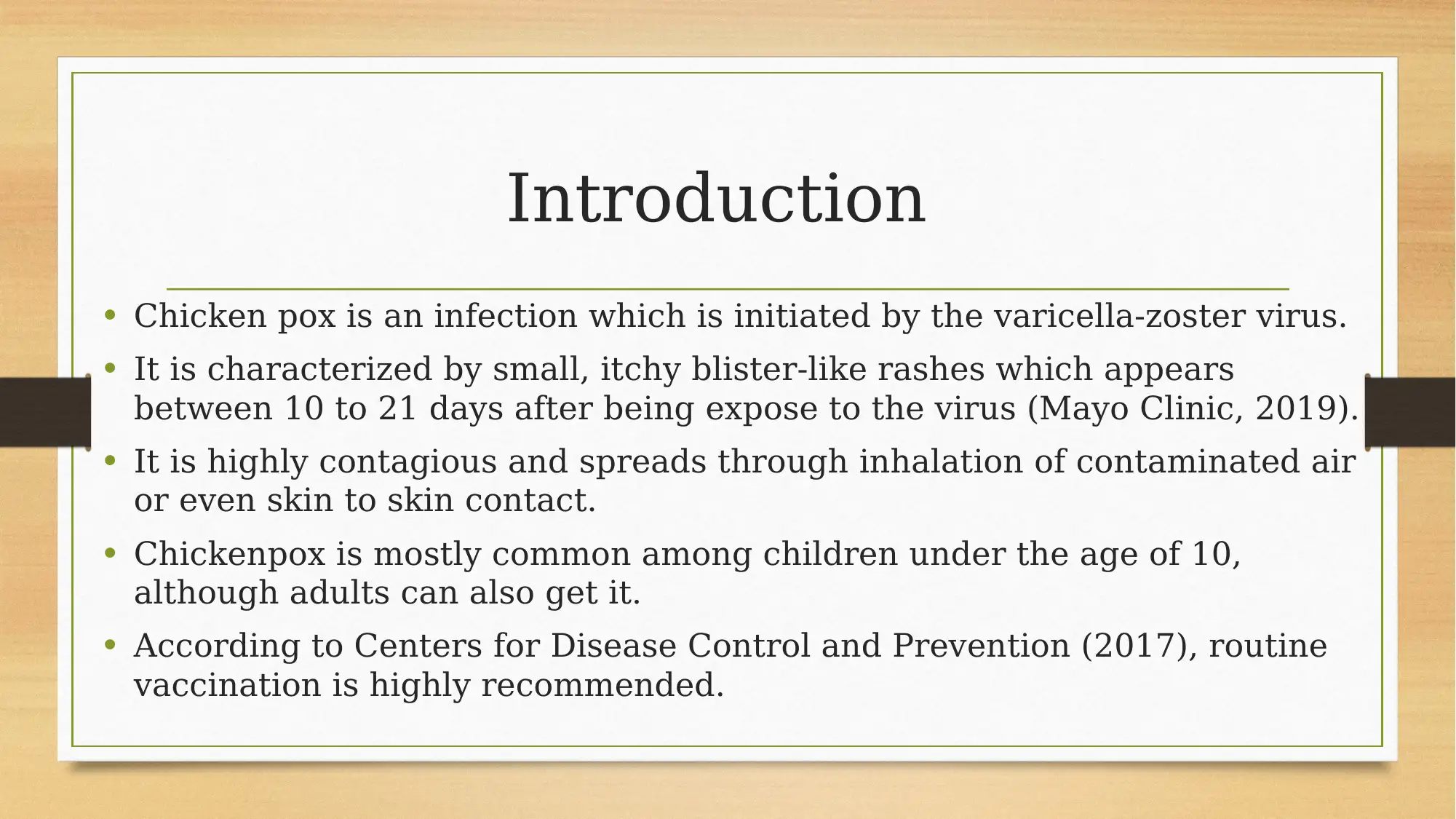
Introduction
• Chicken pox is an infection which is initiated by the varicella-zoster virus.
• It is characterized by small, itchy blister-like rashes which appears
between 10 to 21 days after being expose to the virus (Mayo Clinic, 2019).
• It is highly contagious and spreads through inhalation of contaminated air
or even skin to skin contact.
• Chickenpox is mostly common among children under the age of 10,
although adults can also get it.
• According to Centers for Disease Control and Prevention (2017), routine
vaccination is highly recommended.
• Chicken pox is an infection which is initiated by the varicella-zoster virus.
• It is characterized by small, itchy blister-like rashes which appears
between 10 to 21 days after being expose to the virus (Mayo Clinic, 2019).
• It is highly contagious and spreads through inhalation of contaminated air
or even skin to skin contact.
• Chickenpox is mostly common among children under the age of 10,
although adults can also get it.
• According to Centers for Disease Control and Prevention (2017), routine
vaccination is highly recommended.
⊘ This is a preview!⊘
Do you want full access?
Subscribe today to unlock all pages.

Trusted by 1+ million students worldwide
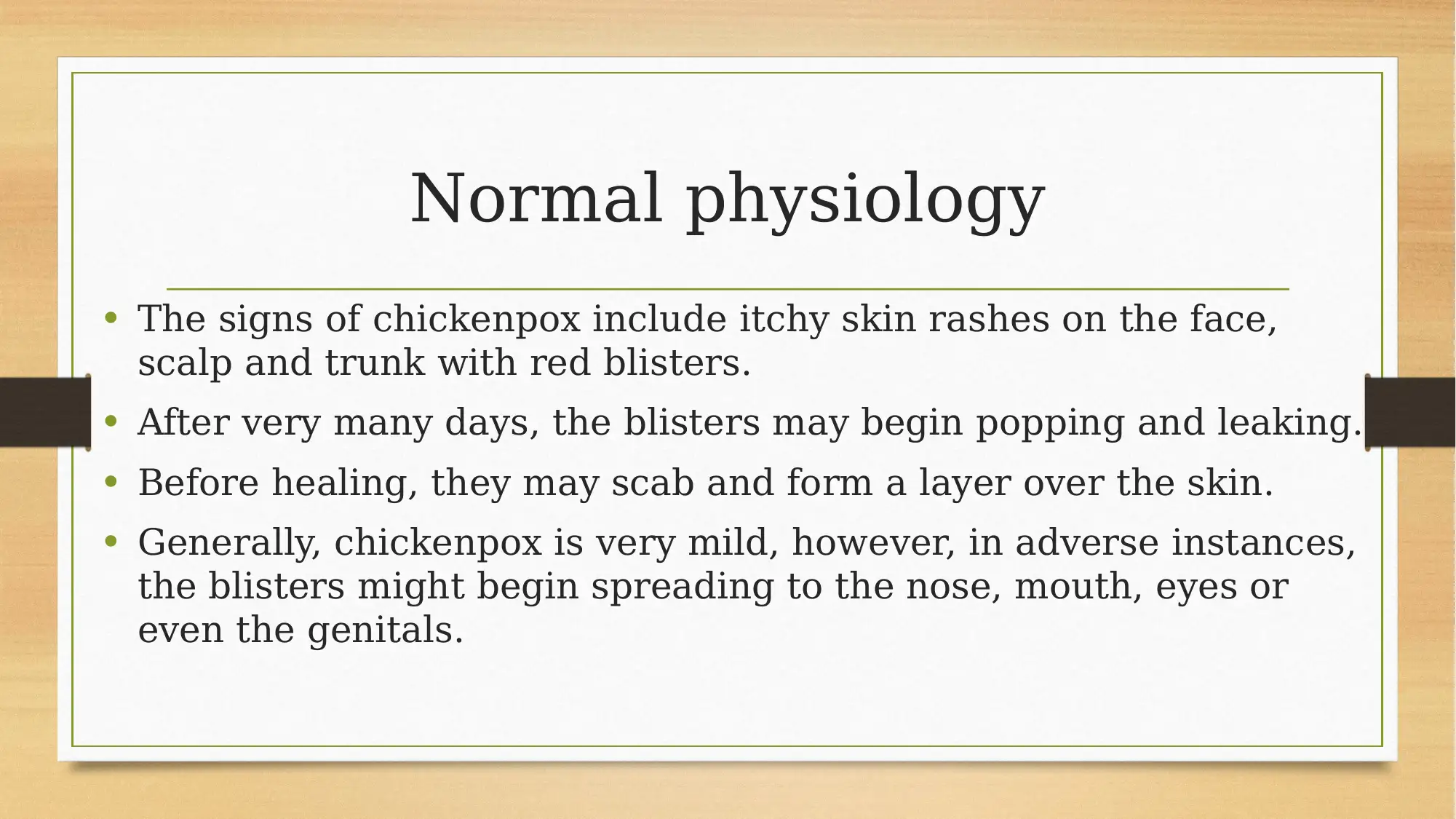
Normal physiology
• The signs of chickenpox include itchy skin rashes on the face,
scalp and trunk with red blisters.
• After very many days, the blisters may begin popping and leaking.
• Before healing, they may scab and form a layer over the skin.
• Generally, chickenpox is very mild, however, in adverse instances,
the blisters might begin spreading to the nose, mouth, eyes or
even the genitals.
• The signs of chickenpox include itchy skin rashes on the face,
scalp and trunk with red blisters.
• After very many days, the blisters may begin popping and leaking.
• Before healing, they may scab and form a layer over the skin.
• Generally, chickenpox is very mild, however, in adverse instances,
the blisters might begin spreading to the nose, mouth, eyes or
even the genitals.
Paraphrase This Document
Need a fresh take? Get an instant paraphrase of this document with our AI Paraphraser
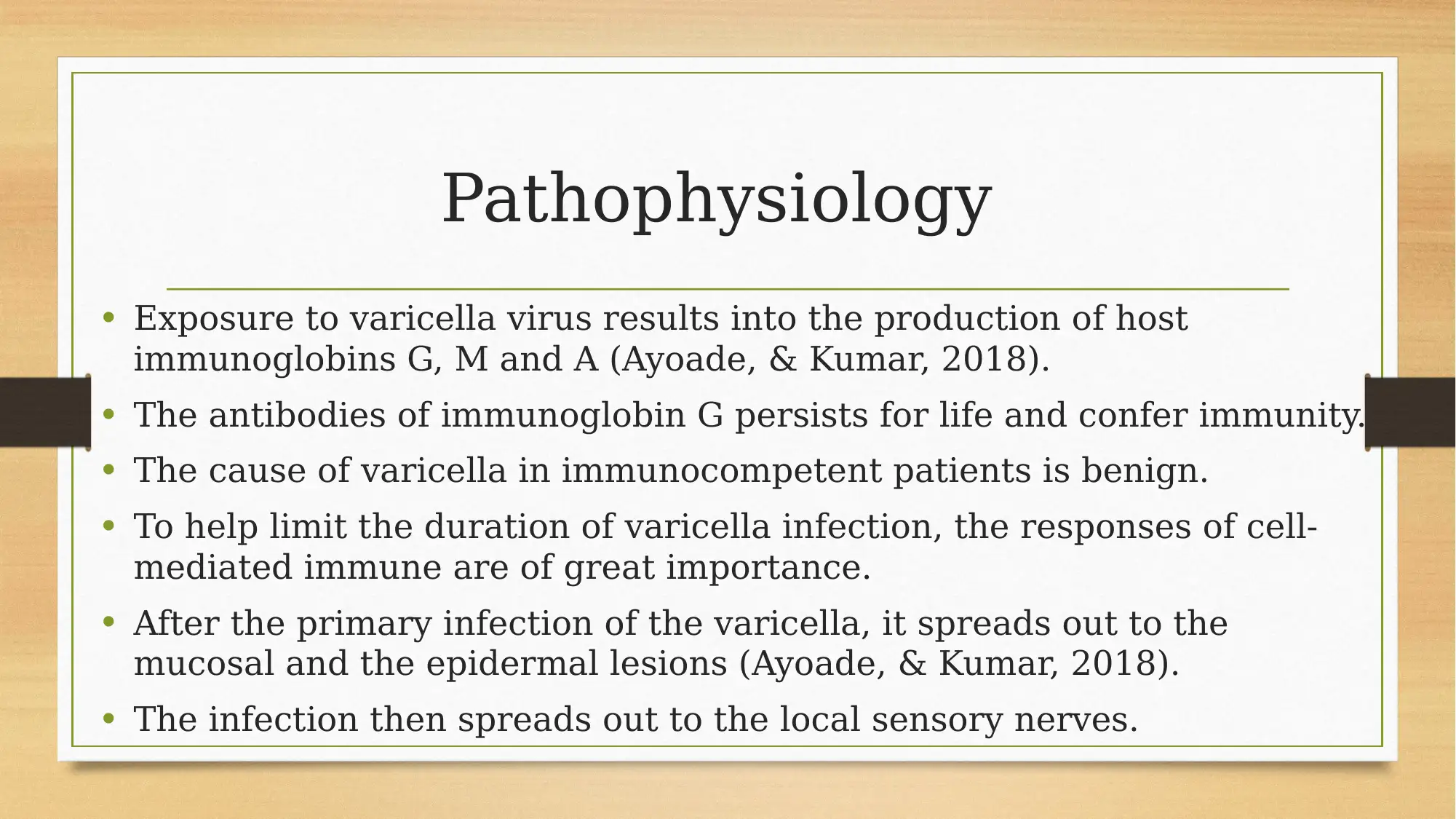
Pathophysiology
• Exposure to varicella virus results into the production of host
immunoglobins G, M and A (Ayoade, & Kumar, 2018).
• The antibodies of immunoglobin G persists for life and confer immunity.
• The cause of varicella in immunocompetent patients is benign.
• To help limit the duration of varicella infection, the responses of cell-
mediated immune are of great importance.
• After the primary infection of the varicella, it spreads out to the
mucosal and the epidermal lesions (Ayoade, & Kumar, 2018).
• The infection then spreads out to the local sensory nerves.
• Exposure to varicella virus results into the production of host
immunoglobins G, M and A (Ayoade, & Kumar, 2018).
• The antibodies of immunoglobin G persists for life and confer immunity.
• The cause of varicella in immunocompetent patients is benign.
• To help limit the duration of varicella infection, the responses of cell-
mediated immune are of great importance.
• After the primary infection of the varicella, it spreads out to the
mucosal and the epidermal lesions (Ayoade, & Kumar, 2018).
• The infection then spreads out to the local sensory nerves.
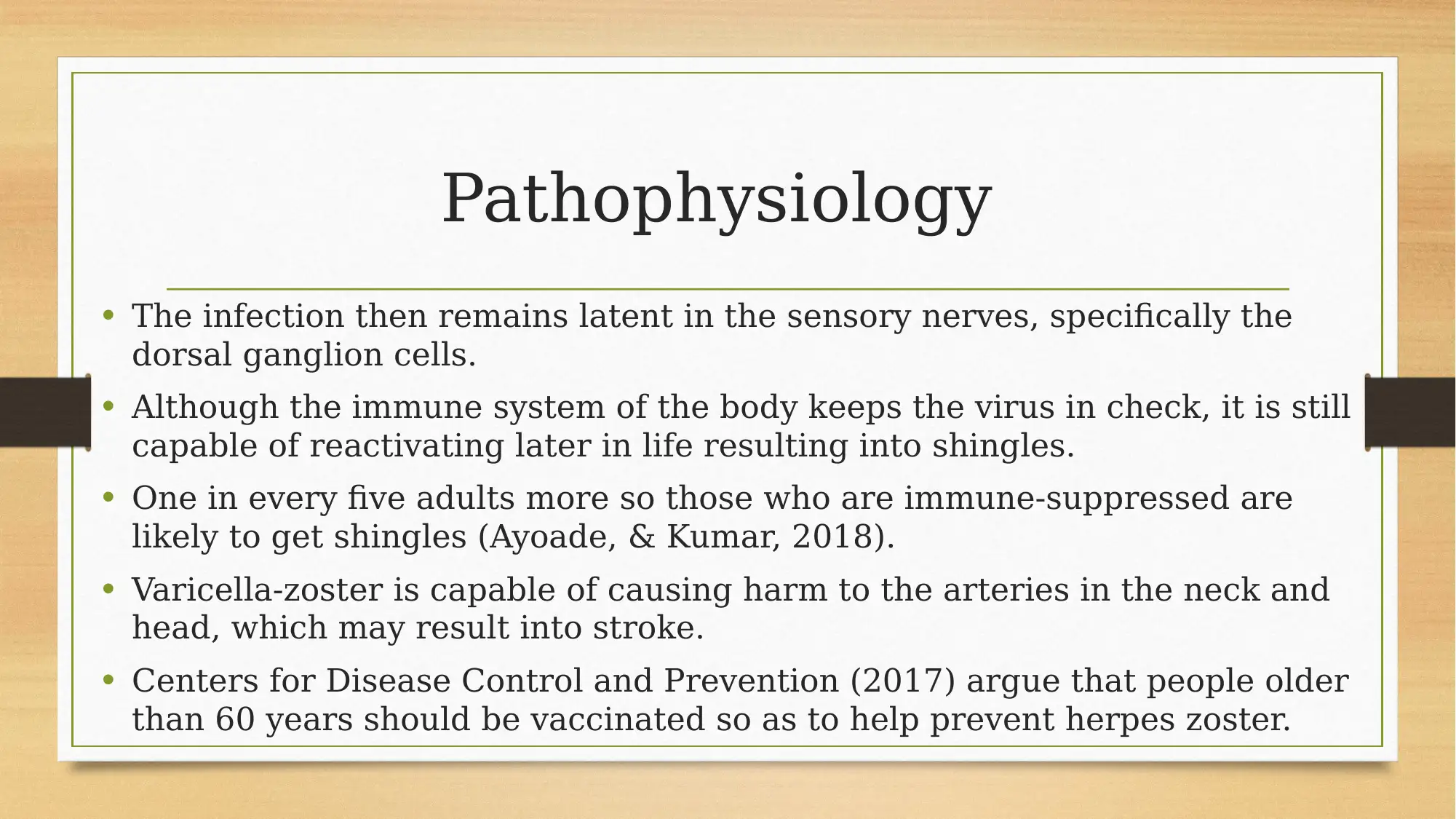
Pathophysiology
• The infection then remains latent in the sensory nerves, specifically the
dorsal ganglion cells.
• Although the immune system of the body keeps the virus in check, it is still
capable of reactivating later in life resulting into shingles.
• One in every five adults more so those who are immune-suppressed are
likely to get shingles (Ayoade, & Kumar, 2018).
• Varicella-zoster is capable of causing harm to the arteries in the neck and
head, which may result into stroke.
• Centers for Disease Control and Prevention (2017) argue that people older
than 60 years should be vaccinated so as to help prevent herpes zoster.
• The infection then remains latent in the sensory nerves, specifically the
dorsal ganglion cells.
• Although the immune system of the body keeps the virus in check, it is still
capable of reactivating later in life resulting into shingles.
• One in every five adults more so those who are immune-suppressed are
likely to get shingles (Ayoade, & Kumar, 2018).
• Varicella-zoster is capable of causing harm to the arteries in the neck and
head, which may result into stroke.
• Centers for Disease Control and Prevention (2017) argue that people older
than 60 years should be vaccinated so as to help prevent herpes zoster.
⊘ This is a preview!⊘
Do you want full access?
Subscribe today to unlock all pages.

Trusted by 1+ million students worldwide
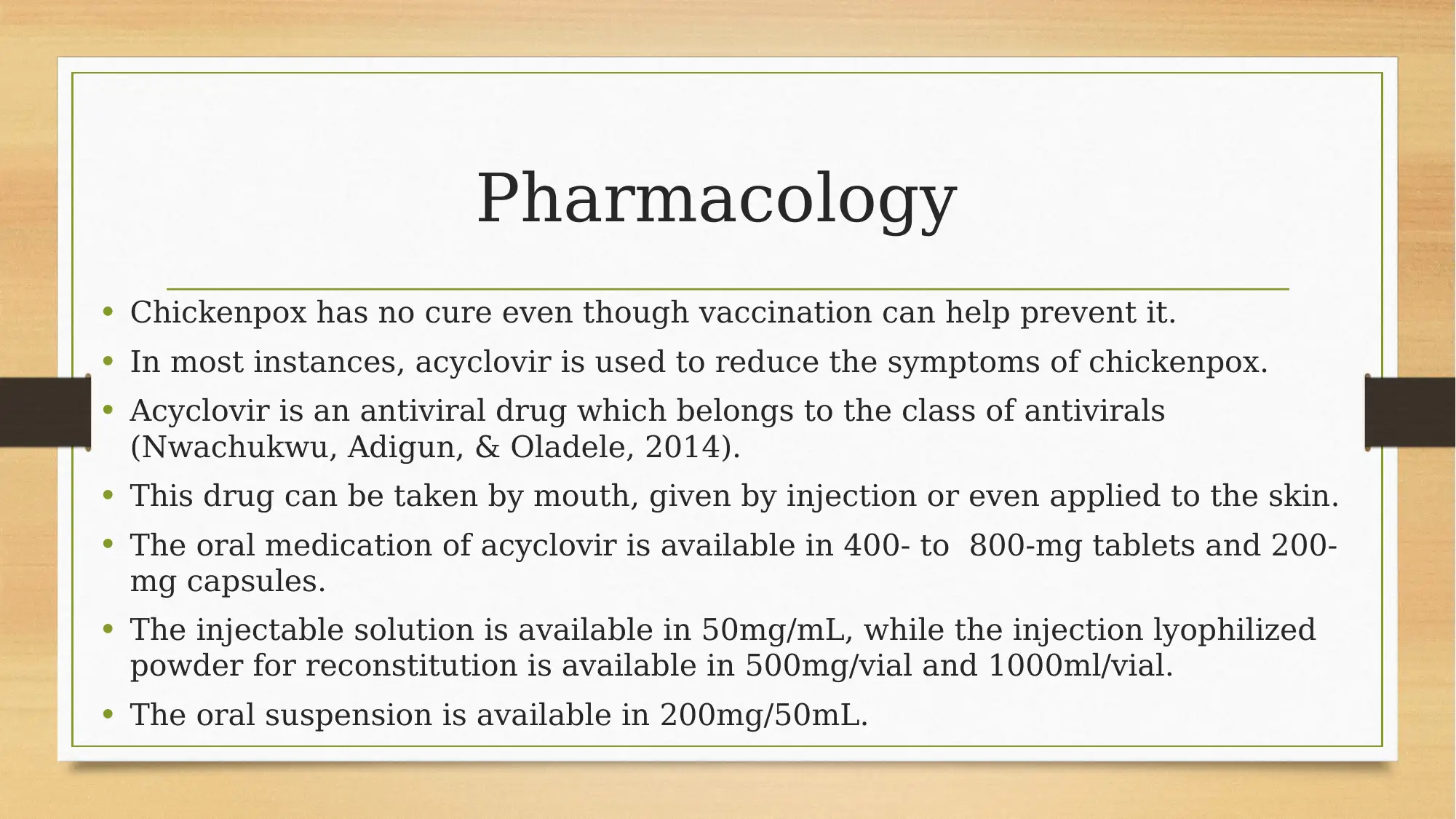
Pharmacology
• Chickenpox has no cure even though vaccination can help prevent it.
• In most instances, acyclovir is used to reduce the symptoms of chickenpox.
• Acyclovir is an antiviral drug which belongs to the class of antivirals
(Nwachukwu, Adigun, & Oladele, 2014).
• This drug can be taken by mouth, given by injection or even applied to the skin.
• The oral medication of acyclovir is available in 400- to 800-mg tablets and 200-
mg capsules.
• The injectable solution is available in 50mg/mL, while the injection lyophilized
powder for reconstitution is available in 500mg/vial and 1000ml/vial.
• The oral suspension is available in 200mg/50mL.
• Chickenpox has no cure even though vaccination can help prevent it.
• In most instances, acyclovir is used to reduce the symptoms of chickenpox.
• Acyclovir is an antiviral drug which belongs to the class of antivirals
(Nwachukwu, Adigun, & Oladele, 2014).
• This drug can be taken by mouth, given by injection or even applied to the skin.
• The oral medication of acyclovir is available in 400- to 800-mg tablets and 200-
mg capsules.
• The injectable solution is available in 50mg/mL, while the injection lyophilized
powder for reconstitution is available in 500mg/vial and 1000ml/vial.
• The oral suspension is available in 200mg/50mL.
Paraphrase This Document
Need a fresh take? Get an instant paraphrase of this document with our AI Paraphraser
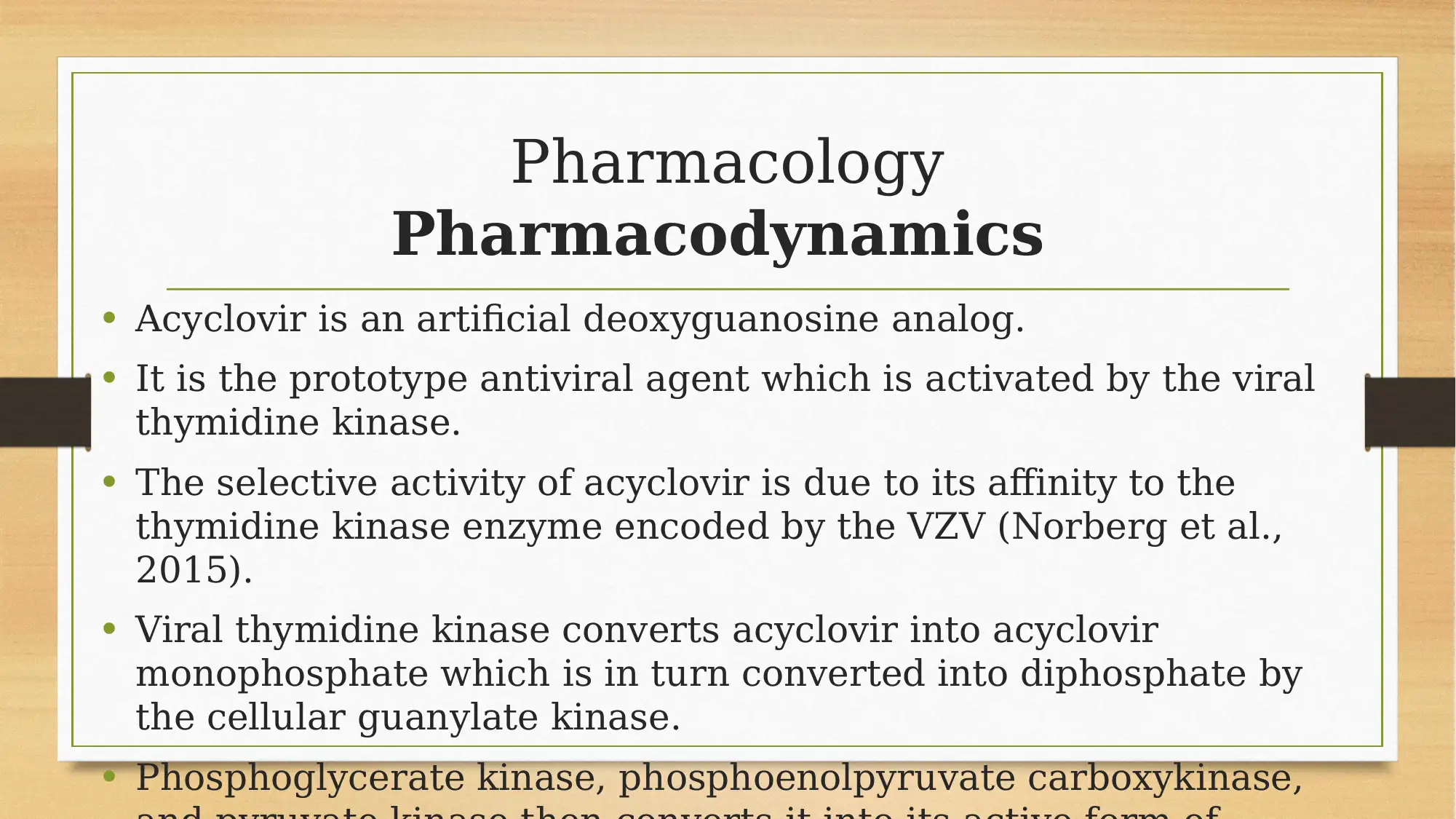
Pharmacology
Pharmacodynamics
• Acyclovir is an artificial deoxyguanosine analog.
• It is the prototype antiviral agent which is activated by the viral
thymidine kinase.
• The selective activity of acyclovir is due to its affinity to the
thymidine kinase enzyme encoded by the VZV (Norberg et al.,
2015).
• Viral thymidine kinase converts acyclovir into acyclovir
monophosphate which is in turn converted into diphosphate by
the cellular guanylate kinase.
• Phosphoglycerate kinase, phosphoenolpyruvate carboxykinase,
Pharmacodynamics
• Acyclovir is an artificial deoxyguanosine analog.
• It is the prototype antiviral agent which is activated by the viral
thymidine kinase.
• The selective activity of acyclovir is due to its affinity to the
thymidine kinase enzyme encoded by the VZV (Norberg et al.,
2015).
• Viral thymidine kinase converts acyclovir into acyclovir
monophosphate which is in turn converted into diphosphate by
the cellular guanylate kinase.
• Phosphoglycerate kinase, phosphoenolpyruvate carboxykinase,
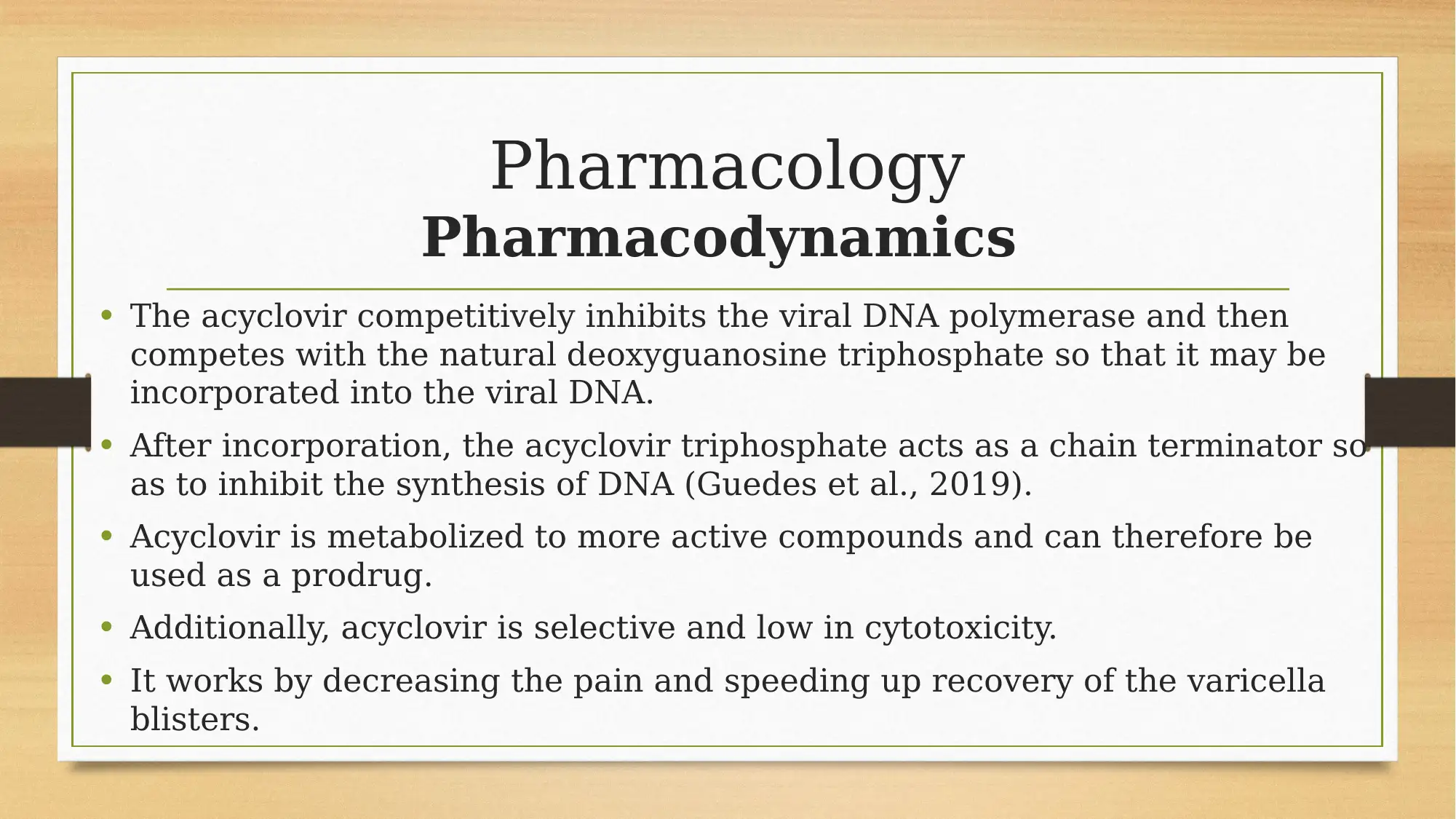
Pharmacology
Pharmacodynamics
• The acyclovir competitively inhibits the viral DNA polymerase and then
competes with the natural deoxyguanosine triphosphate so that it may be
incorporated into the viral DNA.
• After incorporation, the acyclovir triphosphate acts as a chain terminator so
as to inhibit the synthesis of DNA (Guedes et al., 2019).
• Acyclovir is metabolized to more active compounds and can therefore be
used as a prodrug.
• Additionally, acyclovir is selective and low in cytotoxicity.
• It works by decreasing the pain and speeding up recovery of the varicella
blisters.
Pharmacodynamics
• The acyclovir competitively inhibits the viral DNA polymerase and then
competes with the natural deoxyguanosine triphosphate so that it may be
incorporated into the viral DNA.
• After incorporation, the acyclovir triphosphate acts as a chain terminator so
as to inhibit the synthesis of DNA (Guedes et al., 2019).
• Acyclovir is metabolized to more active compounds and can therefore be
used as a prodrug.
• Additionally, acyclovir is selective and low in cytotoxicity.
• It works by decreasing the pain and speeding up recovery of the varicella
blisters.
⊘ This is a preview!⊘
Do you want full access?
Subscribe today to unlock all pages.

Trusted by 1+ million students worldwide
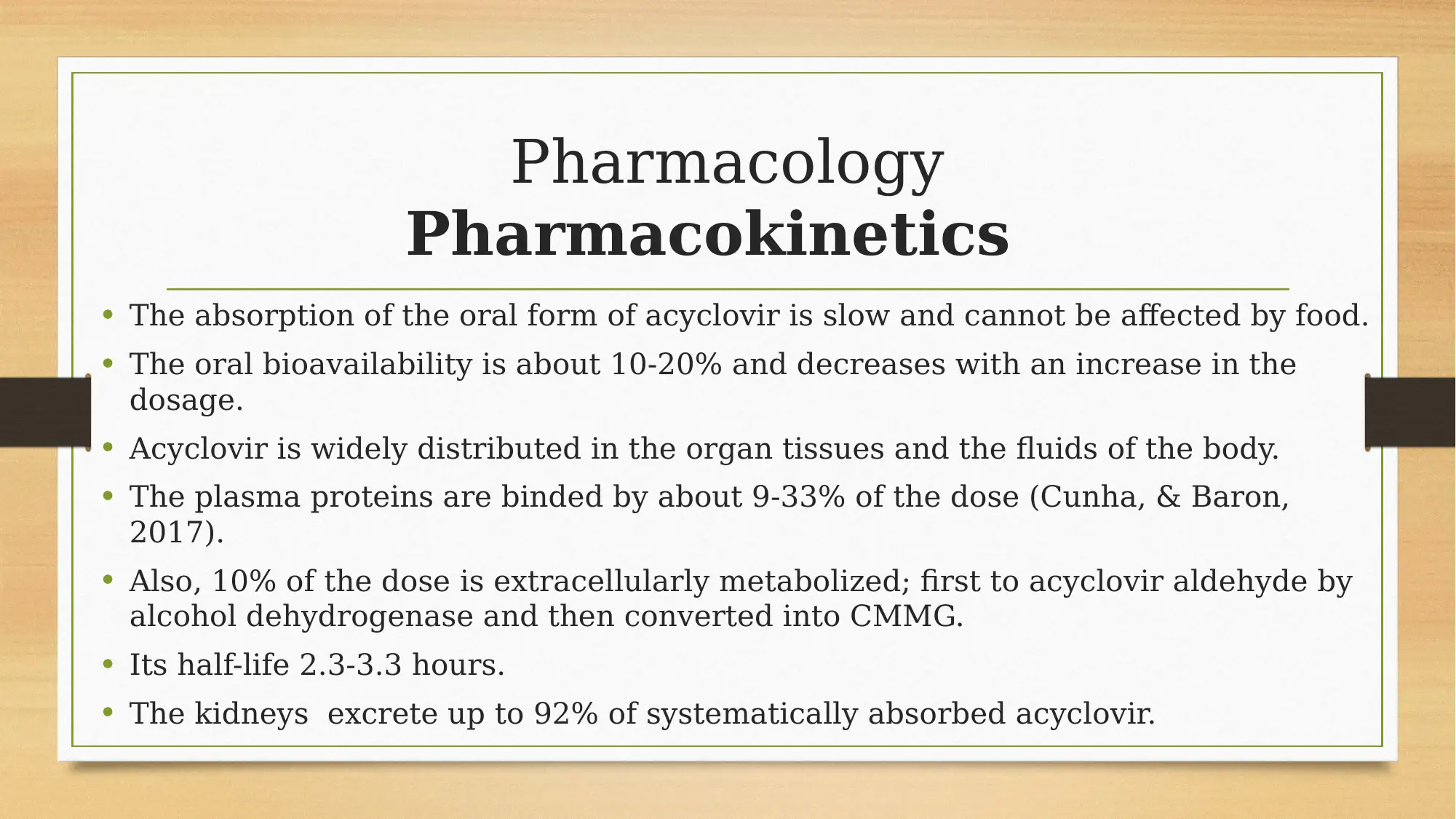
Pharmacology
Pharmacokinetics
• The absorption of the oral form of acyclovir is slow and cannot be affected by food.
• The oral bioavailability is about 10-20% and decreases with an increase in the
dosage.
• Acyclovir is widely distributed in the organ tissues and the fluids of the body.
• The plasma proteins are binded by about 9-33% of the dose (Cunha, & Baron,
2017).
• Also, 10% of the dose is extracellularly metabolized; first to acyclovir aldehyde by
alcohol dehydrogenase and then converted into CMMG.
• Its half-life 2.3-3.3 hours.
• The kidneys excrete up to 92% of systematically absorbed acyclovir.
Pharmacokinetics
• The absorption of the oral form of acyclovir is slow and cannot be affected by food.
• The oral bioavailability is about 10-20% and decreases with an increase in the
dosage.
• Acyclovir is widely distributed in the organ tissues and the fluids of the body.
• The plasma proteins are binded by about 9-33% of the dose (Cunha, & Baron,
2017).
• Also, 10% of the dose is extracellularly metabolized; first to acyclovir aldehyde by
alcohol dehydrogenase and then converted into CMMG.
• Its half-life 2.3-3.3 hours.
• The kidneys excrete up to 92% of systematically absorbed acyclovir.
Paraphrase This Document
Need a fresh take? Get an instant paraphrase of this document with our AI Paraphraser
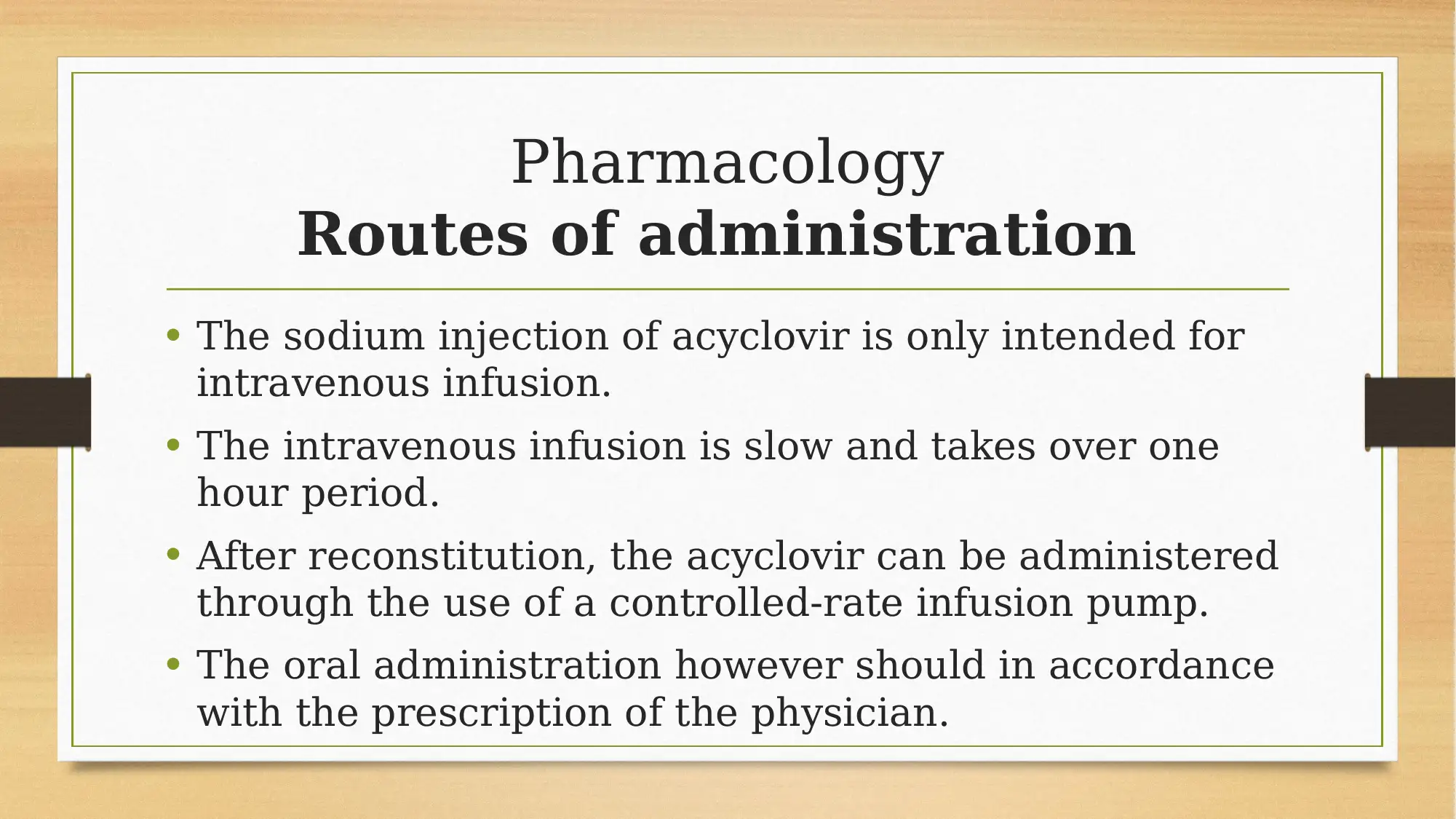
Pharmacology
Routes of administration
• The sodium injection of acyclovir is only intended for
intravenous infusion.
• The intravenous infusion is slow and takes over one
hour period.
• After reconstitution, the acyclovir can be administered
through the use of a controlled-rate infusion pump.
• The oral administration however should in accordance
with the prescription of the physician.
Routes of administration
• The sodium injection of acyclovir is only intended for
intravenous infusion.
• The intravenous infusion is slow and takes over one
hour period.
• After reconstitution, the acyclovir can be administered
through the use of a controlled-rate infusion pump.
• The oral administration however should in accordance
with the prescription of the physician.
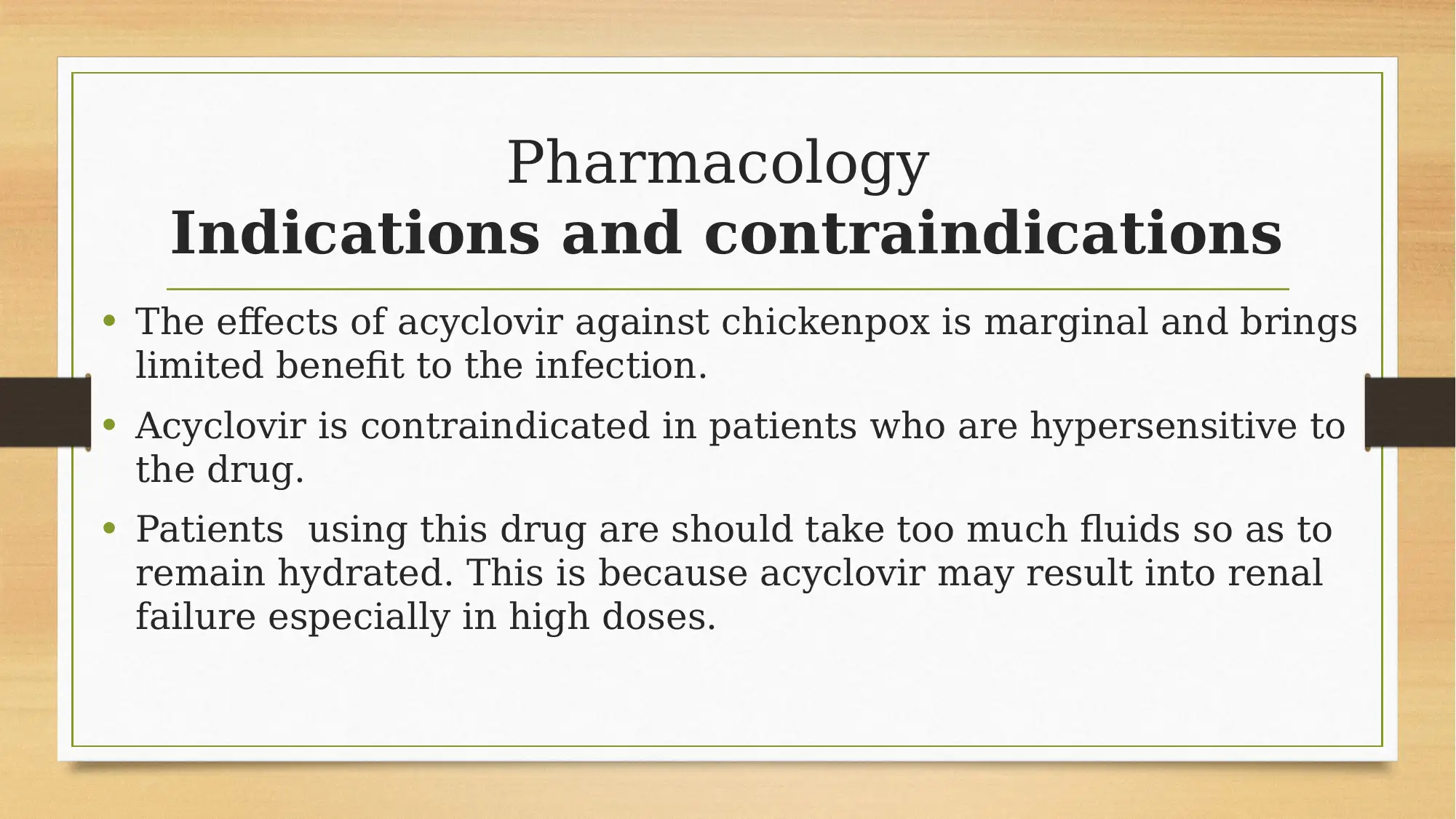
Pharmacology
Indications and contraindications
• The effects of acyclovir against chickenpox is marginal and brings
limited benefit to the infection.
• Acyclovir is contraindicated in patients who are hypersensitive to
the drug.
• Patients using this drug are should take too much fluids so as to
remain hydrated. This is because acyclovir may result into renal
failure especially in high doses.
Indications and contraindications
• The effects of acyclovir against chickenpox is marginal and brings
limited benefit to the infection.
• Acyclovir is contraindicated in patients who are hypersensitive to
the drug.
• Patients using this drug are should take too much fluids so as to
remain hydrated. This is because acyclovir may result into renal
failure especially in high doses.
⊘ This is a preview!⊘
Do you want full access?
Subscribe today to unlock all pages.

Trusted by 1+ million students worldwide
1 out of 17
Your All-in-One AI-Powered Toolkit for Academic Success.
+13062052269
info@desklib.com
Available 24*7 on WhatsApp / Email
![[object Object]](/_next/static/media/star-bottom.7253800d.svg)
Unlock your academic potential
Copyright © 2020–2025 A2Z Services. All Rights Reserved. Developed and managed by ZUCOL.

